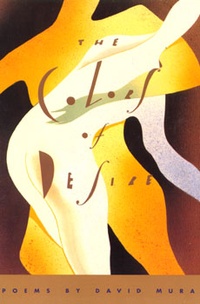David Mura’s sister once said to him, “You talk about things I would rather sweep under the rug.”
In much of his work, award-winning poet, creative nonfiction writer, critic, playwright and performance artist Mura (Turning Japanese: Memoirs of a Sansei, Angels for the Burning) shares deeply personal experiences. Facing racism. Family conflicts. His self-image. Desire and relationships. Sexual awakening. But in publicly baring his soul, Mura also aims to reveal truths about Asian American men that too often remain hidden.
“If I shied away from the truth, I’d be running away from my task as a writer,” says Mura, whose acclaimed book of poetry, The Colors of Desire, won the Carl Sandburg Literary Award from the Friends of the Chicago Public Library. “Over time I’ve learned that I seem to have a higher tolerance than others for revealing things about myself or my life that might seem embarrassing. At the same time, I decided that I was not only writing for myself but for the readers, particularly other Asian Americans, who saw the same things I did and wanted to know that they were not crazy.”
“What do writers do?” Mura asks. “They take out things from under the table and from the closet and throw them in front of people and say, ‘Here are the things left out of your idealized portrait, here is the reality you have failed to acknowledge. Here are the secrets, the crimes, the blemishes, the lies, the wounds, the aberrations, the blasphemies and idiosyncrasies you want to keep silenced, the erasures no one talks about.’ Rather than the accepted simplified portrait, the writer hungers for reality, for its contradictions and complexities.”
Mura notes that one reality affecting many Asian American men is that the American public does not see them as attractive or romantically desirable.
“I’ve often quoted the Japanese American actor Marc Hayashi’s comment to me, ’Every culture needs its eunuchs and we’re it’,” says Mura. “That stereotype still exists, and it’s part of what fuels the lack of images of Asian Americans in the media. I do think that, as strange as it may sound, Harold & Kumar Go to White Castle was a breakthrough film for Asian American males. Harold and Kumar reminded me a lot of any number of young Asian American guys I know, and we’ve never quite seen anything like them before in mainstream films. While they weren’t exactly studly, they weren’t eunuchs either, and Harold did get to kiss the hot Latina, if only in his fantasy.”
“I sometimes use my friend Kelvin Han Yee, as a barometer,” Mura adds. “Kelvin’s a terrific actor; I think of him as an Asian American Larry Fishburne, someone with the chops to do Shakespeare but who also has a street edge to him. Generally, a typical part Kelvin would get called up for was as a Chinese cook who screams in Cantonese at Sean Connery after Connery runs him over while chasing a villain. This year, though, Kelvin can be seen as a doctor on The Young & the Restless, so that gives me some hope.”
While a tough critic of the way ethnic minorities are often portrayed, Mura is quick to acknowledge that the notion of an ideal image of an Asian American is both elusive and inherently subject to debate. And that much of that debate can be internal—making it premium fuel for the fires of a writer’s creativity.
“As Yeats said, ‘We make rhetoric out of our argument with others; we make poetry out of our arguments with ourselves’.”
* This article was originally published on the Japanese American National Museum Store Online on May 2005.
© 2005 Japanese American National Museum







